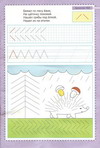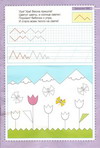Before starting to learn the Russian language, any student must know its basis - the alphabet. You need to learn it in the very first lesson and you need to master this knowledge properly.

Any word in the Russian language consists of sounds, which are the basis of the shell of any word. Each word consists of a different sound design. The combination of letters in a word, as well as the stress, is of great importance.
In any language, including Russian, transcription is used to distinguish letters in words. It is transcription that helps to understand how a word sounds, giving it a generally accepted written form. The transcription will show the softness of the consonants, which syllables are in the word, as well as where the stress is located and which letters fall under it.
The letters of the alphabet can be divided into groups such as vowels and consonants. In addition, vowels can be stressed; this is only six letters. Shocked vowels are those vowels that, when pronouncing a sound, do not encounter an obstacle in the oral cavity. You can put your hand to your throat and feel how the ligaments vibrate. Any vowel can be shouted and sung. It is vowels that are the basis of any word, but stressed syllables sound distinctly, while unstressed syllables are more colorless.
Consonant sounds usually encounter an obstacle in their path during pronunciation. Usually such sounds are quite difficult to pronounce if they are in a row. The Russian language does not have words that consist only of consonants. Consonants can also be divided into voiced and voiceless, as well as paired and unpaired sounds.
Capital letters

When studying the alphabet, you must also study the writing of letters, as well as punctuation marks. Large capital letters will be very important and needed in all further education of children. To develop handwriting, you will need to show your child different fonts that are used to write a particular capital letter.
For the correct design of letters while writing, you can make reminders for children. You just need to take sheets of paper that are in A4 format, on which to print suitable and various stencils with capital letters. Use a wide variety of fonts so that children can best remember how to write one or another letter of the Russian language. Such pictures can be colored, you can draw small elements of decoration on them, but in such a way that they do not distract from the information that the stencils contain.
You can use classic comb-over fonts, original writing, floral and festive designs, the main thing is to show your imagination and involve children in creating such an alphabet; they will be interested in decorating and coloring capital letters on paper that is in A4 format.
Lowercase letters
Learn the rules of how to write lowercase letters no less important than the big ones. Therefore, in order to learn the entire alphabet this way, it would also be a good idea to use similar stencils and different fonts that can be printed on paper that is in A4 format.
Then lowercase letters will be learned much easier by children, and if printed pictures are hung up as an example, then children will better remember the Russian alphabet and learn to write different fonts using printed stencils as an example. It is the stencils that will become the basis quick memorization children of certain lowercase letters.
Russian alphabet
Nowadays, we don’t often have to write by hand - more and more we use a keyboard, and recently technologies such as voice input have appeared. And it is not surprising that writing is becoming a problem - every year there are more and more children who have difficulty learning to write capital letters, and more and more adults who have lost the skill beautiful handwriting. How to fix this? This manual “Learning to write letters by dots” will come to the aid of both adults and children.
Many people believe that handwriting depends on natural talent. And if your handwriting is clumsy and unclear, there is no way to fix it. But it has long been proven that if you really want something and try your best, then everything will definitely work out. We will give you some tips on how to develop your handwriting so that it becomes clear and beautiful.
Most effective way– develop your handwriting one letter at a time. This is very painstaking, but not meaningless work. Write one letter many times until you like the result. This may take more than one sheet of paper, but your efforts will definitely bring results.
Using copybooks it is easiest to learn to write letters using dots. Working with them, you will have correct and even handwriting. It is worth going through the registration in full and, possibly, more than once. It’s not difficult to study according to the recipes - everything is clear and clearly shown there, you just need to diligently repeat it.
To write beautifully, you need to sit up straight and not slouch. This is very important, because if you sit in the wrong position, it’s unlikely that anything will come of it. Also, many people think that when you write, only your wrist is involved. But that's not true. Our shoulders also help us write.
Try writing in the air by drawing lines. Experts say that after you transfer this to a piece of paper, your handwriting will become more accurate and smoother. Soon he will be absolutely perfect.
Search the web for fonts that you like. And you can carefully copy them.
These recipes are suitable for classes with preschoolers 5-6 years old, but should not be given to children younger age. In 3-4 year olds, the hand is not yet sufficiently formed to print such small elements as letters and numbers. Do not rush, otherwise you may overstrain small muscles, which will lead to further problems with the development of handwriting in the child. For kids, we recommend using special ones.
You should also distinguish between copybooks for left-handers and right-handers. This material is suitable for right-handed children. If you or your child writes with the left hand, download special ones.
Remember: you can achieve beautiful handwriting only through your own work and diligence, and the copybooks “Learning to write letters by dots” will help you with this. Good luck!
Russian alphabet- a successive series of letters that convey the sound composition of Russian speech and create the written and printed form of the Russian language. The Russian alphabet goes back to the Cyrillic alphabet, in modern form exists since 1918.
Contains 33 letters, 20 of them convey consonants (b, p, v, f, d, t, z, s, zh, sh, h, c, sch, g, k, x, m, n, l, r ); 10 - vowel sounds (a, e, o, ы, и, у) or (in certain positions) combinations j + vowel (i, e, yu); the letter “th” conveys “and non-syllabic” or j; “ъ” and “ь” do not denote separate sounds. The Russian alphabet serves as the basis for the alphabets of some other languages.
History of the alphabet in Rus'
Around 863, the brothers Constantine (Cyril) the Philosopher and Methodius from Thessaloniki (Thessaloniki), by order of the Byzantine Emperor Michael III, streamlined the writing system for the Slavic language.
The brothers were natives of the city of Thessaloniki (now Thessaloniki). Ancient Thessaloniki was a bilingual city, in which, in addition to Greek language Slavic dialect sounded.
Constantine, being a very educated man, even before his trip to Moravia, he compiled Slavic alphabet and began to translate the Gospel into Slavic. In Moravia, Constantine and Methodius continued to translate church books from Greek into the Slavic language, teaching the Slavs to read, write and conduct worship in the Slavic language. The brothers stayed in Moravia for more than three years, and then went with their disciples to Rome to the Pope. On the way to Rome, they visited another Slavic country - Pannonia (the region of Lake Balaton, Hungary). And here the brothers taught the Slavs books and worship in the Slavic language.
In Rome, Constantine became a monk, taking the name Cyril. There, in 869, Kirill was poisoned. Methodius with his disciples, who received the priesthood, returned to Pannonia, and later to Moravia.
By that time, the situation in Moravia had changed dramatically. After the death of Rostislav, his captive Svyatopolk became the Moravian prince, who submitted to German political influence. The activities of Methodius and his disciples took place in very difficult conditions. The Latin-German clergy in every way prevented the spread of the Slavic language as the language of the church.
Methodius was sent to prison, where he died in 885, and after that his opponents managed to achieve the ban on Slavic writing in Moravia. After the adoption of Christianity, Bulgaria became the center of the spread of Slavic writing.
Here Slavic schools are created, the original Cyril and Methodius liturgical books are copied.
The widespread use of Slavic writing dates back to the reign of Simeon in Bulgaria (893-927). Later, the Old Church Slavonic language penetrated into Serbia, and at the end of the 10th century. becomes the language of the church in Kievan Rus.

Now let's go back to our time and see what modern capital letters of the Russian alphabet look like. Correct spelling capital letters- the key to legible and beautiful handwriting.

Russian alphabet - capital letters
Russian alphabet in pictures for children
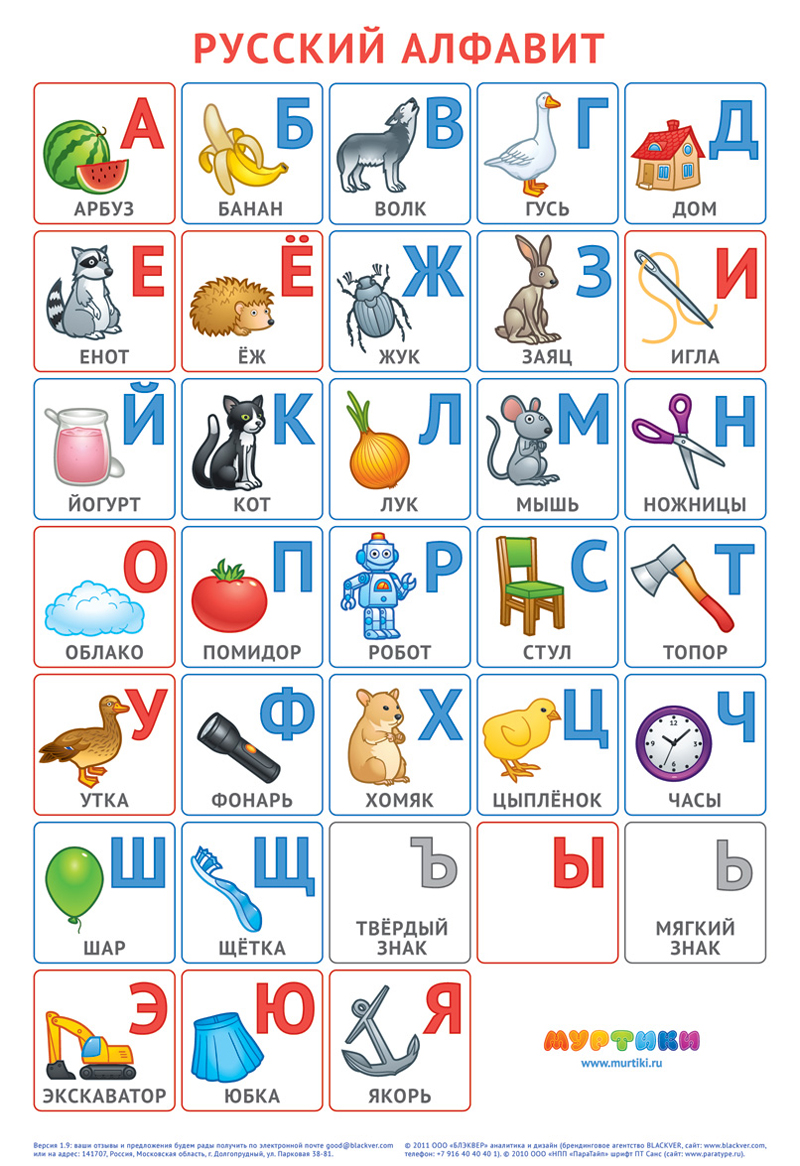
Thank you for the project material provided
Writing is a universal carrier of information, religion, culture and politics. It is impossible not to note the very main role of the Russian state’s own writing: it is likely that it was the alphabet that preserved this people and did not allow them to assimilate into a foreign culture.
After all “Language is the spirit of the people”(W. Humboldt), in language is the entire worldview of a nation, the subtlest features of perception, there is no People without Language!
How to learn to write? This question plagues many parents. If this was previously done in elementary school, then today a child goes to first grade with basic skills. To develop them, you can use materials for preschoolers; store shelves are literally littered with them. But where to start and how to make sure that classes do not turn into torture for your child? Let's figure it out together.
Learning to write - developing fine motor skills.
Ideally, prepare your child for writing a couple of years before school. The most optimal thing is to start at four years old. After all, at this age he can already approach the issue intelligently, but he still has enough time to hone his skills. The baby must master fine motor skills. There are effective ways to develop it:
1) buy a construction set with no large parts. Let him fantasize and collect whatever he wants;
2) for girls, a hobby in which beads or seed beads are strung on a thread can be useful;
3) many people like to sculpt from plasticine or clay; you must agree, this is a very useful and entertaining pastime;
4) and finally, the notorious coloring books are also useful in the development of motor skills, just try to buy one whose characters are interesting to your baby.
By the way, this develops not only motor skills, but also contributes to the formation of attentiveness, perseverance, accuracy and improvement of the eye. And this, without a doubt, will be useful to your baby.
Only when he takes up the pen, do not forget that in order to write beautifully and quickly, he must hold the pencil or pen correctly. Correct mistakes at the root, rather than relearn them for a long time and persistently. By the way, special attachments have appeared on sale that help him hold a pen or pencil.
Learning to write - first copybooks.
When you see that the hand is already ready and does not go beyond the boundaries when coloring, you can begin to copy-paste. This is a very important step for a baby. Of course, at first he won’t succeed. Don't rush or put pressure on him. Even the most horribly written squiggle should receive your praise. Also, ignore the dirt, have fun, this is the only way you can interest your baby.
The first jobs are easy. Before writing, master drawing lines and squiggles. We recommend starting with straight lines, then moving on to inclined lines, and then to curved ones. Pictures will help, with dotted lines for connections. Multi-colored notebooks with small poems or stories are perfect for studying. The more exciting the process, the more effective it will be.
(Click to print)

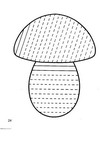
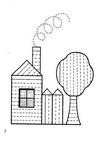
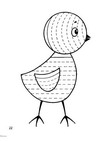
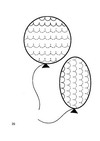
When drawing various stripes is well mastered, you can move on to geometric shapes. Of course, it will be more interesting for the child not only to trace squares or triangles, but to build a real drawing out of them.
(Click to print)

Learning to write - copybooks for the second stage.
When he is already confidently tracing the dotted lines different shapes and length, you can try to proceed to the second stage. Materials where you need to continue the drawing, shade it, or try to repeat a geometric figure will help. At this stage, notebooks may no longer be so bright; as a rule, they begin to study at the age of five or six years, when he already understands that this is important for his later life. Evaluate efforts more strictly, pay attention to dirt and sloppiness. And yet, do not forget to praise your little worker, especially if you see that he is trying and thinking.


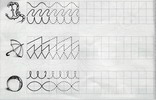
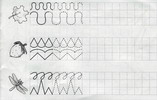
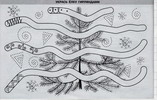
Learning to write letters and numbers.
When he independently learned to draw straight lines and geometric shapes, you should gradually begin to enter letters and numbers. To begin with, these can only be their elements. For example, some drawings that include the same curves. For more diligent and purposeful children, it is suitable where the elements of letters and numbers are written in a row. You need to know the alphabet and numbers, it will be much easier.
(Click to enlarge to print)
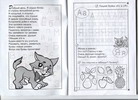
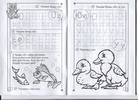
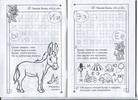
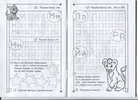
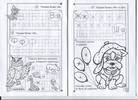
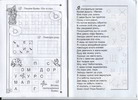
By the way, if your student has already learned to write in print, and there is still enough time left before school, you can try working with him as with first-graders. If he writes, it will be much easier for him later. This requires your baby's attention to the copybooks. After all, capital letters are written according to certain rules so that they can be combined into words. Find a copybook where everything is drawn with arrows showing directions.
Learning to write - attitude.
Attitude is also an important factor. Psychologists have long found out that the beauty and accuracy of handwriting largely depends on the emotional state. You can’t start if the baby is upset. In addition, never compare your baby with other children, especially if the comparison is not in his favor. Never scold a student if he fails to write, but praise him as much as possible for success. Before writing accurately, a long and difficult path will be covered, be a support. Motivation is also important in the mood. You need to really want to write; not only praise, but also a reward (for example, a coveted book) would be quite appropriate.
Among other things, keep in mind that learning also torments the child himself. And this is a huge pressure, especially if you rush it or constantly underestimate it. He may have a protest when he stops trying, and it will be very, very difficult to reverse this situation. Therefore, the more patient you are, the happier your baby will be.
Learning to write - helping the child relax after class.
For you, writing symbols or even words costs nothing, but for your child it is hard mental and physical work, after which he needs to rest and recover. First of all, the time for preschoolers should not exceed twenty minutes. After working on your homework, we advise you to somehow distract yourself. For example, outdoor games or reading a book. It would be a good idea to relax your arm muscles. To do this, you can do the well-known exercise “we wrote, we wrote, our fingers are tired,” or have a short massage session. Focus your attention on your hands and forearms. In order to relax them, you can lightly pinch the muscles, stroke or gently pat them. Such a massage will not only be useful, but also pleasant for the baby.
Learning to write - how to deal with inattention.
Many parents complain that their children are extremely inattentive while peeing. Indeed, kids, whose life until recently consisted of nothing but games and entertainment, are quite reluctant to sit down to write their own copybooks. As mentioned earlier, you need to prepare physically and mentally. It would be nice if studying brought pleasure not only to him, but also to you. Believe me, he will immediately notice if you are bored. Therefore, you cannot simultaneously watch TV, listen to music or anything else. Immerse yourself as much as possible and help when necessary.
Of course, perseverance also depends on the psychological type of a particular child. Some people cannot sit still for long periods of time. Provide the most comfortable and calm environment possible. Make sure nothing can distract him. If you notice that during the process he begins to change his position frequently, it means he needs a warm-up. It's okay if work is interrupted for a minute for a little charging.
Plus, mindfulness can be developed like any other skill. A warm-up called “each letter has its own color” is suitable for this. Agree with your child that each letter will have its own color (in the game, use only a few, not the entire alphabet), then dictate them to him quickly, but so that he has time to change the pencil and write the letter.
Learning to write - a few fundamental rules.
Whatever copybook you choose, in order to teach effectively, you need to adhere to a couple of rules.
1) Move from simple to more complex. Even if your baby shows extraordinary mental abilities, it’s worth starting with the basics.
2) The more colorful and interesting the copybooks are at first, the more wonderful it will be. It's good for a child to get carried away.
3) Remember about praise and encouragement. But remember that they must be deserved. You need to clearly understand that “you can’t even pull a fish out of the pond without effort.”
4) He will draw more than one copybook with squiggles. Don't worry if he doesn't get it right away, learning is a fairly long process.
5) Never put pressure, much less raise your voice, on him. If you see that a child does not work, you should firmly but calmly find out the reason why he has no desire. If the baby is simply tired, stop the activity.
6) Do not be guided by the principle that the more you write, the better. The lessons will be of higher quality and more exciting, and then he will be less tired.
7) Recently, it has been widely believed that it is best to learn to write with an ordinary soft pencil. Research shows that indeed, at the beginning of classes with the help a simple pencil the correct pressure is generated.
8) Don’t forget that all children are different, and each one needs an approach. And it’s easiest for parents to find it. And absolutely anyone can be taught to write accurately. True, if your baby is left-handed, quiet, or, conversely, fidgety, you will have to spend a lot of effort on this.
In conclusion, I would like to say that the ability to write beautifully, accurately and competently is a merit not only of teachers and the children themselves, but also of parents who do not waste their lives and work with their kids. Therefore, if your child is already four years old, hurry up to buy a lot of different materials, and also be patient and understanding; you are guaranteed hard work for a couple of years. But the pride in your child, who will receive excellent grades, will more than pay off all the efforts.


